Long Read Sequencing Market Research, 2032
The global long read sequencing market was valued at $0.7 billion in 2022, and is projected to reach $5.2 billion by 2032, growing at a CAGR of 21.7% from 2023 to 2032. The surge in genetic disorders and cancer underscores the demand for long read sequencing technologies. These conditions, influenced by various genetic factors, benefit from the comprehensive genome analysis that long read sequencing offers. It facilitates the identification of rare variants crucial in disease understanding. For instance, the WHO's estimation of 400,000 annual childhood cancer cases globally highlights the urgency for advanced genomic tools. Long read sequencing's ability to unveil genetic intricacies supports precision medicine and enhances clinical outcomes for affected individuals.
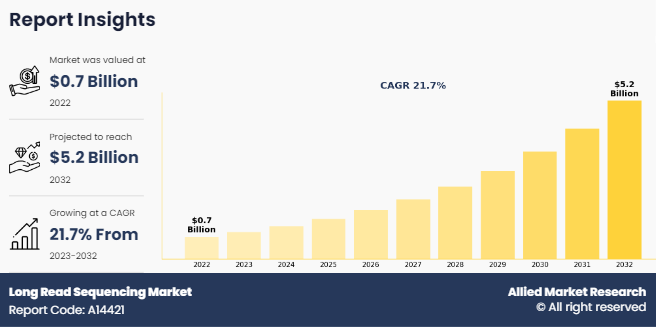
Long-read sequencing, a third-generation DNA sequencing technique, overcomes limitations of short-read sequencing by generating DNA reads exceeding 10,000 bases. This technology enhances genomics research by providing comprehensive insights into complex genomic regions crucial for understanding disease mechanisms, evolutionary processes, and genetic diversity. With applications in pathogen evolution, cancer research, and clinical diagnostics, long-read sequencing holds immense potential to revolutionize healthcare and advance precision medicine initiatives. Long read sequencing facilitates comprehensive analysis of complex genomic regions, repetitive sequences, and structural variations. Overall, long read sequencing revolutionizes genomic research by providing detailed and accurate genomic information.
Key Takeaways
By application, the research application segment dominated the long read sequencing market size in 2022. However, the clinical application segment is anticipated to grow at the highest CAGR during the forecast period.
By technique, the single-molecule real-time sequencing (SMRT) segment dominated the market in 2022. However, the nanopore sequencing segment is anticipated to grow at the highest CAGR during the forecast period.
By product, the consumables segment dominated the long read sequencing market size in 2022. However, the instrument segment is anticipated to grow at the highest CAGR during the forecast period.
By end user, the pharmaceutical and biotechnological companies segment was largest contributor to the market in 2022. However, academic and government research institutes segment is anticipated to grow at the highest CAGR during the forecast period.
Region wise, North America generated the largest revenue in 2022. However, Asia-Pacific is anticipated to grow at the highest CAGR during the forecast period.
Market Dynamics
Rise in acceptance of modern approaches for medical diagnostics represents one of the key factors that propels the market growth. The growing demand for long read sequencing technology can also be attributed to its real-time speed and enhanced capabilities to analyze entire genomes comprehensively, enabling the identification of rare genetic variants and structural variations crucial in understanding diseases like cancer and genetic disorders. Furthermore, the utilization of sequence analysis methodologies in medical institutes for academic purposes, in confluence with increasing investments in research and development activities further contribute to the market growth. Thus, rise in utilization reflects the recognition of the importance of high-quality genomic data in advancing biomedical research and clinical diagnostics, thereby fueling the long read sequencing market growth.
In addition, the rise in adoption of various strategies by the key players such and product launch, approval, collaborations are further contributing to the market growth. For instance, in Jan 2024, PacBio a leading developer of high-quality, highly accurate sequencing solutions announced PanDNA, a versatile Nanobind DNA extraction kit. This new offering expands the array of sample types suitable for long-read sequencing, including cells, bacteria, blood, tissue, plant nuclei, and insects. Similarly, in august 2023, Element Biosciences, Inc., developer of the Element AVITI System, an innovative DNA sequencing platform that is disrupting the genomics industry, unveiled five new products to better serve customers’ low to medium throughput needs and expand the functionality and versatility of its benchtop sequencer. Thus, rise in technological advancement and surge in availability of the products provides long read sequencing market opportunity.
However, the initial costs of implementing long read sequencing technologies can be considerable, covering specialized platforms, bioinformatics software, and lab infrastructure. Moreover, recruiting skilled personnel adept in operating and maintaining these technologies further increases expenses. This substantial initial investment presents a formidable barrier to adoption, particularly for smaller research institutions, clinical labs, and companies with constrained financial resources. Consequently, the cost factor poses a challenge, hindering widespread integration of long read sequencing in such settings.
Segments Overview
The long read sequencing market is segmented on the basis of application, technique, product, end user, and region. By application, it is bifurcated into research application and clinical application. By technique, the market is categorized into single-molecule real-time sequencing (SMRT), nanopore sequencing and synthetic long read sequencing. On the basis of product, it is segmented into instruments, consumables, and services. The instrument segment is further classified into system and software. By end user, it is segregated into academic and government research institutes, pharmaceutical and biotechnological companies, hospitals and clinics, and others. Region wise, the market is analyzed across North America (U.S., Canada, and Mexico), Europe (Germany, France, UK, Italy, Spain, and rest of Europe), Asia-Pacific (Japan, China, India, Australia, South Korea, and rest of Asia-Pacific), and LAMEA (Brazil, South Africa, Saudi Arabia, and rest of LAMEA).
By Application
The research application segment dominated the market share in 2022, owing to increased funding for genomic research and wider adoption of sequencing technologies in research environments. In addition, the advancing evolution of sequencing platforms and bioinformatics tools expands their applicability across diverse research domains like genomics, transcriptomics, epigenomics, and metagenomics, reinforcing the segment's prominence. However, the clinical application segment is expected to register the highest CAGR during the long read sequencing market forecast period, owing to the increasing integration of genomic information into clinical practice, particularly in areas such as oncology, rare diseases, and infectious diseases, is driving the demand for sequencing technologies for diagnostic, prognostic, and therapeutic purposes.
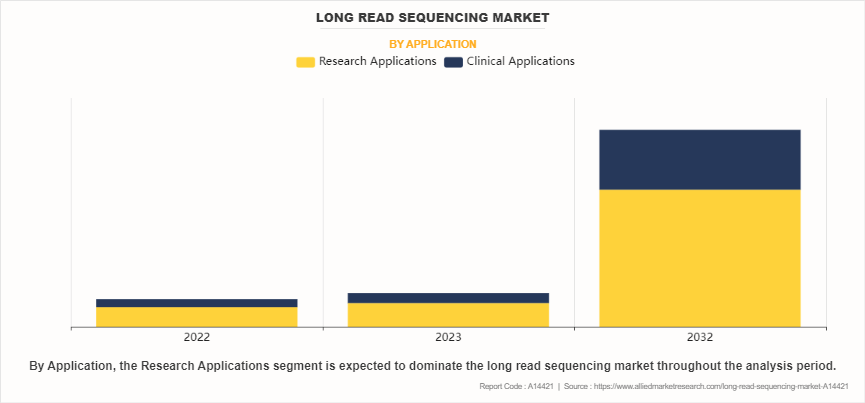
By Technique
The single-molecule real-time sequencing (SMRT) segment dominated the long read sequencing market share in 2022, owing to its superior accuracy, minimized sequencing biases, and enhanced capability in detecting structural variants. Its versatility across genomics, clinical diagnostics, and research applications further solidified its dominance. Ongoing technological advancements and cost-efficiency improvements continue to propel its adoption and maintain its leadership position in the market. However, the nanopore sequencing segment is expected to register the highest CAGR during the forecast period. This is attributed to ongoing advancements in nanopore technology, facilitating longer reads, heightened accuracy, and increased portability. Moreover, nanopore sequencing's capability to directly detect DNA/RNA molecules in real-time, without necessitating amplification or intricate sample preparation, serves as a significant driver for its adoption in forecast period.
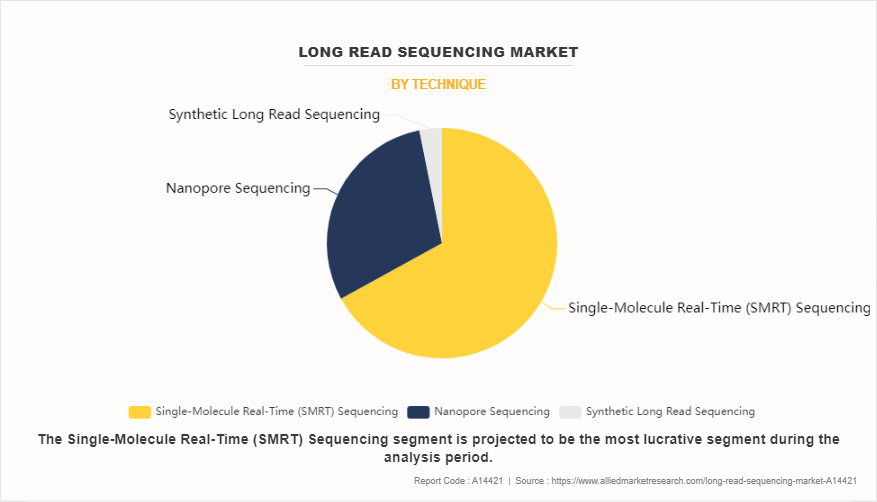
By Product
The consumables segment dominated the long read sequencing market share in 2022. This is attributed to recurring nature of consumable purchases, such as reagents, cartridges, and other materials necessary for sequencing experiments, ensures a steady revenue stream for sequencing companies. In addition, the rise in adoption of sequencing technologies across research, clinical, and industrial settings boosts the demand for consumables. However, the instruments segment is expected to register the highest CAGR during the forecast period. This is attributed to ongoing technological advancements in sequencing instruments, which include enhancements in speed, accuracy, and throughput, thereby spurring the demand for upgraded systems. In addition, the influx of new players and the launch of innovative platforms are anticipated to further bolster the segment's growth.
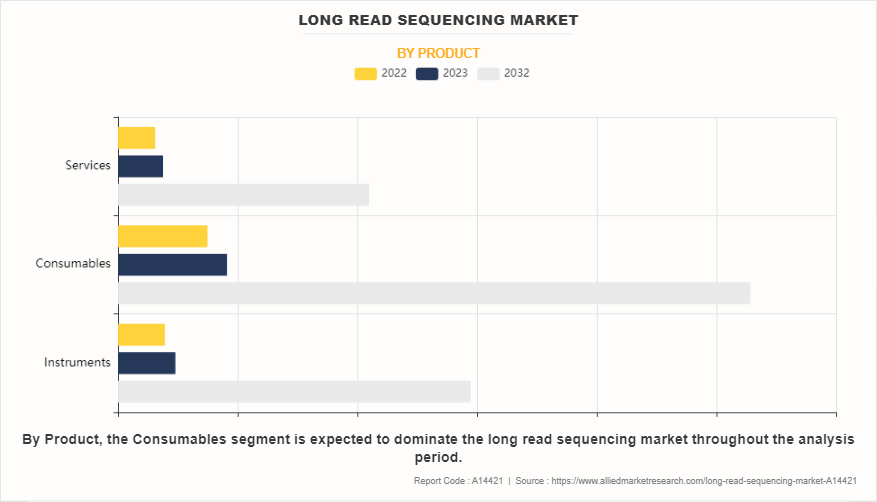
By End User
The pharmaceutical and biotechnological companies segment dominated the market share in 2022. Pharmaceutical and biotechnology companies are increasingly investing in sequencing technologies to support drug discovery and development efforts, including target identification, biomarker discovery, and personalized medicine initiatives, thus dominating the segment growth. However, the academic and government research institutes segment is expected to register the highest CAGR during the forecast period. The increasing availability of research funding, and collaborative initiatives supports the adoption of sequencing technologies in academic and government research settings. In addition, the surge in emphasis on multidisciplinary research projects, such as large-scale genomics initiatives, drives the segment growth.
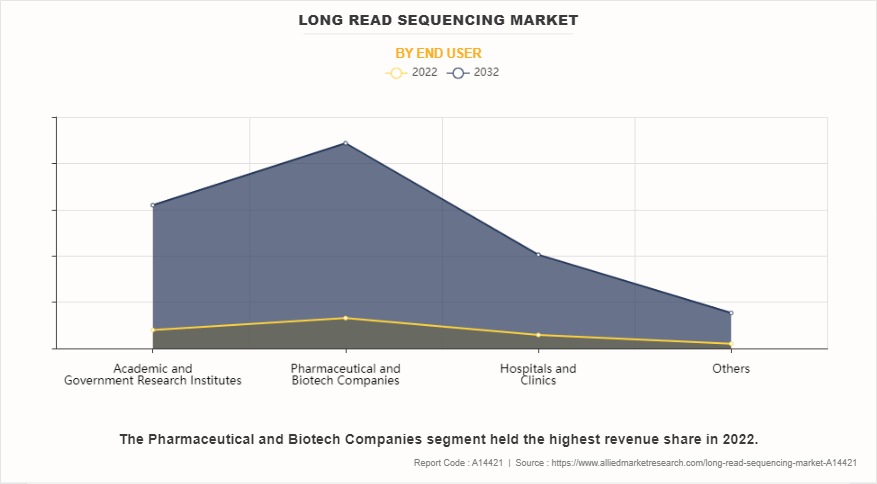
By Region
The long read sequencing industry is analyzed across North America, Europe, Asia-Pacific, LAMEA. North America has accounted for the largest share in the long read sequencing market and is expected to remain dominant during the forecast period. This dominance is attributed to its advanced healthcare infrastructure along with a strong emphasis on technological innovation. Furthermore, the strong presence of key players in the region is further contributing to market growth in the region. However, the Asia-Pacific region is anticipated to register the highest CAGR during the forecast period. This is attributed to rapid economic growth in the region. In addition, the increased investment in healthcare infrastructure, research and development, and biotechnology sectors, further contributes to the market growth.
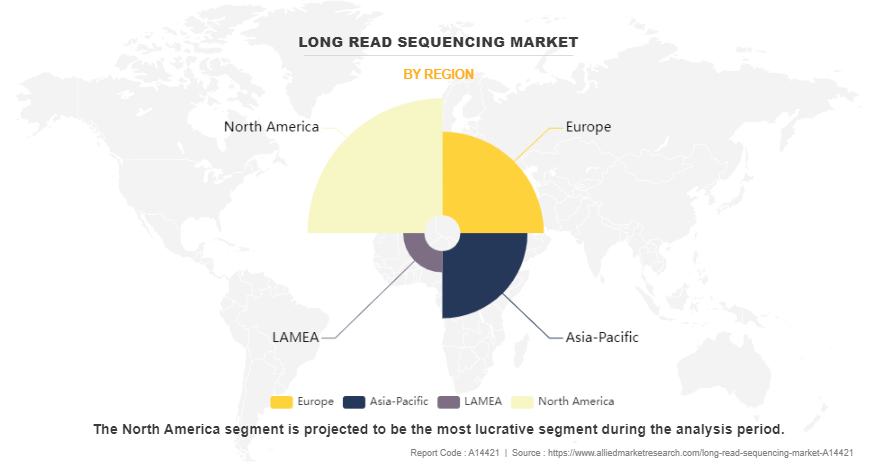
Competitive Analysis
Key players such as Oxford Nanopore Technologies plc and PacBio have adopted expansion, and product launch as key developmental strategies to improve the product portfolio of the long read sequencing market. For instance, in April 2021, Pacific Biosciences of California, Inc. announced the availability of HiFi Sequencing and Software v10.1 Release on the Sequel II and Sequel IIe Systems. The new release increases the number of HiFi reads at or above 99.9% accuracy (QV30) for whole genome sequencing-based applications. This combined release further improves the quality of HiFi Sequencing while providing an efficient and scalable workflow for sequencing hundreds to thousands of whole human genomes per year on Sequel II and IIe Systems.
Recent Developments in the Long Read Sequencing Industry
In August 2021, Pacific Biosciences of California, Inc. announced that it acquired Circulomics Inc., a Maryland-based biotechnology company focused on delivering highly differentiated sample prep products that enable genomic workflows. Scientists recognize Circulomics as a leader in extracting high quality, high molecular weight (HMW) DNA from almost any sample type. These products are commonly used for long read applications across a diverse set of markets including human biomedical research, plant and animal sciences and microbiology.
In August 2021, Oxford Nanopore Technologies plc, signed a distribution agreement with Avantor, a leading global provider of mission-critical products and services to customers in the life sciences, advanced technologies, and applied materials industries. The agreement enables scientists to have broader access and support of Oxford Nanopore’s portable, information-rich, real-time nanopore sequencing device, MinION.
Key Benefits for Stakeholders
This report provides a quantitative analysis of the market segments, current trends, estimations, and dynamics of the long read sequencing market analysis from 2022 to 2032 to identify the prevailing market opportunities.
The market research is offered along with information related to key drivers, restraints, and opportunities.
Porter's five forces analysis highlights the potency of buyers and suppliers to enable stakeholders make profit-oriented business decisions and strengthen their supplier-buyer network.
In-depth analysis of the long read sequencing market segmentation assists to determine the prevailing market opportunities.
Major countries in each region are mapped according to their revenue contribution to the global market.
Market player positioning facilitates benchmarking and provides a clear understanding of the present position of the market players.
The report includes the analysis of the regional as well as global long read sequencing market trends, key players, market segments, application areas, and market growth strategies.
Long Read Sequencing Market Report Highlights
| Aspects | Details |
| Market Size By 2032 | USD 5.2 billion |
| Growth Rate | CAGR of 21.7% |
| Forecast period | 2022 - 2032 |
| Report Pages | 395 |
| By Application |
|
| By Technique |
|
| By Product |
|
| By End User |
|
| By Region |
|
| Key Market Players | Illumina, Inc., MicrobesNG, Element Biosciences, TAKARA HOLDINGS INC., Oxford Nanopore Technologies plc., GrandOmics, Thermo Fisher Scientific Inc. , CD Genomics, St Vincents Hospital Melbourne, Danaher Corporation, FG Technologies, Novogene co., ltd., Cantata Bio, BGI Genomics, PacBio, Agilent Technologies, Inc., BaseClear B.V. |
Analyst Review
This section provides various opinions of global long read sequencing market. The global long read sequencing market is expected to exhibit high growth potential due to rise in prevalence of cancer and genetic disorders and the advantages offered by long read sequencing. However, the high cost associated with long read sequencing systems limits the growth of the market. In addition, key players have adopted various strategies to strengthen their foothold in the competitive market. In addition, the rise in number of research and development and the expanding applications of the long read sequencing is further contributing to its market growth.
Furthermore, North America dominated the market share in 2022, owing to substantial investment in genomics research and development, supported by government funding, private investments, and academic collaborations. Moreover, the presence of advanced healthcare infrastructure, favorable regulatory policies, and a strong focus on precision medicine initiatives further propel the adoption of long read sequencing technologies. However, Asia-Pacific is anticipated to witness notable growth, owing to rapid economic growth, increased investment in healthcare infrastructure, rise in research and development, and biotechnology sectors, fostering a conducive environment for
the adoption of advanced genomic technologies such as long read sequencing.
The total market value of long read sequencing market is $0.7 billion in 2022.
The market value of long read sequencing market in 2032 is $5.2 billion.
The forecast period for long read sequencing market is 2023 to 2032.
The base year is 2022 in long read sequencing market.
North America is accounted for the largest market share in 2022 owing to well established healthcare infrastructure, substantial investments in research and development, particularly in areas such as personalized medicine, cancer genomics, supportive government initiatives, favorable regulatory frameworks, and significant funding for genomics research.
Increase in demand of long read for applications such as genome assembly, structural variant detection, and transcriptome analysis across various fields including biomedical research and expanding clinical utility are key factors driving the growth of the long-read sequencing market
Long-read sequencing refers to a type of DNA sequencing technology that can generate longer sequence reads compared to traditional short-read sequencing methods.
Loading Table Of Content...
Loading Research Methodology...



